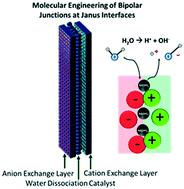当前位置:
X-MOL 学术
›
Mol. Syst. Des. Eng.
›
论文详情
Our official English website, www.x-mol.net, welcomes your feedback! (Note: you will need to create a separate account there.)
Promoting water-splitting in Janus bipolar ion-exchange resin wafers for electrodeionization
Molecular Systems Design & Engineering ( IF 3.6 ) Pub Date : 2020-03-04 , DOI: 10.1039/c9me00179d Matthew L. Jordan 1, 2, 3, 4 , Lauren Valentino 4, 5, 6, 7 , Nargiza Nazyrynbekova 1, 2, 3, 4 , Varada Menon Palakkal 1, 2, 3, 4 , Subarna Kole 1, 2, 3, 4 , Deepra Bhattacharya 1, 2, 3, 4 , Yupo J. Lin 4, 5, 6, 7 , Christopher G. Arges 1, 2, 3, 4
Molecular Systems Design & Engineering ( IF 3.6 ) Pub Date : 2020-03-04 , DOI: 10.1039/c9me00179d Matthew L. Jordan 1, 2, 3, 4 , Lauren Valentino 4, 5, 6, 7 , Nargiza Nazyrynbekova 1, 2, 3, 4 , Varada Menon Palakkal 1, 2, 3, 4 , Subarna Kole 1, 2, 3, 4 , Deepra Bhattacharya 1, 2, 3, 4 , Yupo J. Lin 4, 5, 6, 7 , Christopher G. Arges 1, 2, 3, 4
Affiliation

|
Electrochemical separation processes are undergoing a renaissance as the range of applications continues to expand because they offer opportunities for increased energy efficiency and sustainability in comparison to conventional separation technologies. Existing platforms such as electrodialysis and electrodeionization (EDI) are seeing significant improvement and are currently being deployed for treating a diverse set of liquid streams (e.g., water and wastewater treatment, organic acid separation, etc.). In addition, the relatively low inherent electricity requirement for electrochemical separations could potentially be satisfied through integration with sustainable sources of renewable energy. In order to achieve a truly sustainable electrochemical separations process, it is paramount to improve the energy efficiency of electrochemical separations by minimizing all sources of resistances within these units. This work reports of a new class of symmetric and asymmetric Janus bipolar resin wafers (RWs) that augment the spacer channel ionic conductivity in EDI while having the additional functionality of splitting water into protons and hydroxide ions. The latter attribute is important in niche applications that require pH modulation such as silica and organic acid removal from liquid streams. The Janus bipolar RWs were devised from single ion-conducting RWs that were interfaced together to create an intimate polycation–polyanion junction. Interestingly, the conductivity of the single ion-conducting RWs at low salt concentrations was observed to be dependent on the ionic mobilities of the counterions that the RW was transferring. Using single ion-conducting RWs to construct Janus bipolar RWs enabled the incorporation of a water-splitting catalyst (aluminum hydroxide nanoparticles) into the porous ion-exchange resin bed. To the best of our knowledge, this is the first time a water dissociation catalyst has been implemented in the ion-exchange resin bed for EDI. The water dissociation catalyst in bipolar junctions pre-polarizes water making it easier to split into hydronium and hydroxide ion charge carriers under applied electric fields via the second Wien effect. The new molecularly layered Janus RWs demonstrate both satisfactory water-splitting and salt removal in bench scale EDI setups and these materials may improve, or even supplant, existing bipolar membrane electrodialysis units that currently necessitate large electrolyte feed concentrations.
中文翻译:

促进Janus双极性离子交换树脂晶片中的水分解以进行电去离子
电化学分离工艺正经历复兴,因为其应用范围不断扩大,因为与传统的分离技术相比,它们提供了提高能源效率和可持续性的机会。现有的平台(例如电渗析和电去离子(EDI))正在显着改善,目前正用于处理多种液体流(例如水和废水处理,有机酸分离等)。)。另外,通过与可持续的可再生能源整合可以潜在地满足电化学分离相对较低的固有电力需求。为了实现真正可持续的电化学分离过程,最重要的是通过最小化这些单元内的所有电阻源来提高电化学分离的能效。这项工作报告了一种新型的对称和不对称Janus双极树脂晶片(RW),它们可增加EDI中的间隔通道离子电导率,同时具有将水分解为质子和氢氧根离子的附加功能。在需要调节pH值的利基应用(例如从液体流中去除二氧化硅和有机酸)的利基应用中,后一个属性非常重要。Janus双极RW是由单离子传导RW设计而成的,它们相互连接在一起以形成紧密的聚阳离子-聚阴离子连接。有趣的是,观察到在低盐浓度下单离子导电RW的电导率取决于RW正在转移的抗衡离子的离子迁移率。使用单离子导电RW来构建Janus双极RW,可以将水分解催化剂(氢氧化铝纳米颗粒)掺入多孔离子交换树脂床中。据我们所知,这是首次在用于EDI的离子交换树脂床中使用水离解催化剂。双极结中的水离解催化剂将水预极化,使其在施加电场下更容易分裂为水合氢离子和氢氧根离子电荷载体通过第二个维恩效应。新的分子分层Janus RW在台式EDI装置中显示出令人满意的水分解和除盐性能,这些材料可能会改善甚至取代现有的双极膜电渗析装置,而目前双极膜电渗析装置目前需要大量的电解质进料。
更新日期:2020-03-04
中文翻译:

促进Janus双极性离子交换树脂晶片中的水分解以进行电去离子
电化学分离工艺正经历复兴,因为其应用范围不断扩大,因为与传统的分离技术相比,它们提供了提高能源效率和可持续性的机会。现有的平台(例如电渗析和电去离子(EDI))正在显着改善,目前正用于处理多种液体流(例如水和废水处理,有机酸分离等)。)。另外,通过与可持续的可再生能源整合可以潜在地满足电化学分离相对较低的固有电力需求。为了实现真正可持续的电化学分离过程,最重要的是通过最小化这些单元内的所有电阻源来提高电化学分离的能效。这项工作报告了一种新型的对称和不对称Janus双极树脂晶片(RW),它们可增加EDI中的间隔通道离子电导率,同时具有将水分解为质子和氢氧根离子的附加功能。在需要调节pH值的利基应用(例如从液体流中去除二氧化硅和有机酸)的利基应用中,后一个属性非常重要。Janus双极RW是由单离子传导RW设计而成的,它们相互连接在一起以形成紧密的聚阳离子-聚阴离子连接。有趣的是,观察到在低盐浓度下单离子导电RW的电导率取决于RW正在转移的抗衡离子的离子迁移率。使用单离子导电RW来构建Janus双极RW,可以将水分解催化剂(氢氧化铝纳米颗粒)掺入多孔离子交换树脂床中。据我们所知,这是首次在用于EDI的离子交换树脂床中使用水离解催化剂。双极结中的水离解催化剂将水预极化,使其在施加电场下更容易分裂为水合氢离子和氢氧根离子电荷载体通过第二个维恩效应。新的分子分层Janus RW在台式EDI装置中显示出令人满意的水分解和除盐性能,这些材料可能会改善甚至取代现有的双极膜电渗析装置,而目前双极膜电渗析装置目前需要大量的电解质进料。


























 京公网安备 11010802027423号
京公网安备 11010802027423号